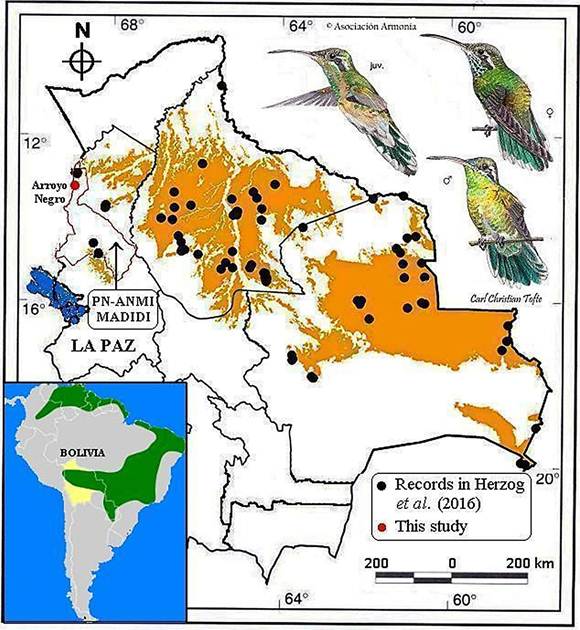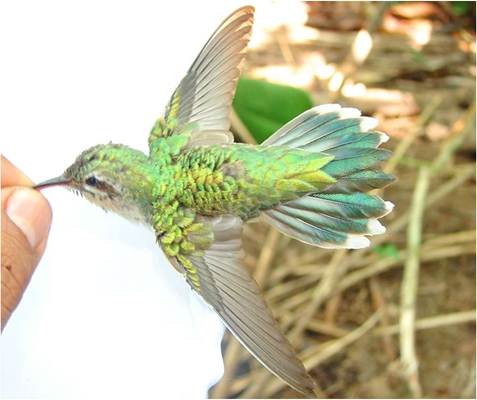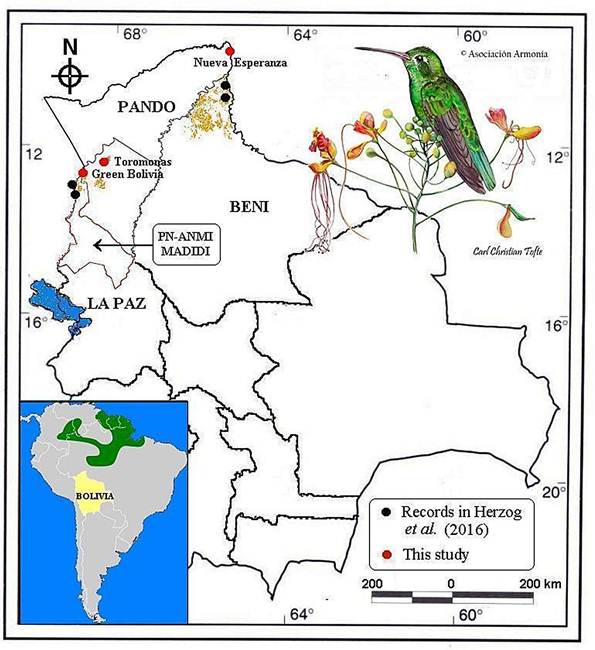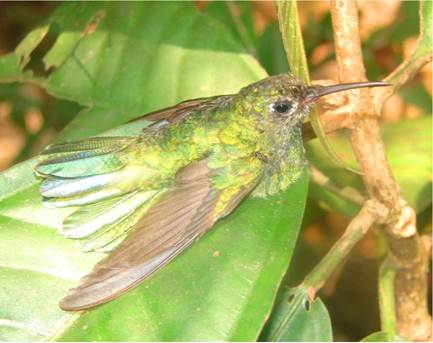The Trochilidae family is the most numerous of the nonpasserine birds and exclusive of the New World, distributed from Alaska to Tierra del Fuego, reaching a diversity of 365 species (Schuchmann et al. 2020), of which 246 are typical of South America (Remsen et al. 2021). Three species of the genus Polytmus are known in South America (Remsen et al. 2021), from Venezuela, central and eastern Brazil to northeastern Argentina: one of them (P. milleri), with a very limited distribution, is endemic to tepuis in eastern Venezuela and Roraima (Brazil), while the others two (P. guainumbi and P. theresiae) are savannah and Amazonian humid forest species (Rodriguez-Mata et al. 2006, Schuchmann et al. 2020).
In Bolivia occur 79 species of hummingbirds, two of them of the genus Polytmus (P. theresiae and P. guainumbi) (Herzog et al. 2016), of which only P. guainumbi was known in the country until early 2000 (Hennessey et al. 2003). In the last decade the presence of P. theresiae was reported, mainly in northern Beni (Herzog et al. 2016) and Pampas del Heath, northern La Paz (Martinez et al. 2021). Here I report a new record of White-tailed Goldenthroat (P. guainumbi) for northern La Paz (Madidi National Park) and three records of Green-tailed Goldenthroat (P. theresiae), two for lowlands of the La Paz Department at adjacent areas to Madidi National Park and the first record for Pando Department, Bolivia.
White-tailed Goldenthroat Polytmus guainumbi thaumantias (Linnaeus 1766)
White-tailed Goldenthroat (Polytmus guainumbi) is a widespread Neotropical hummingbird ranging from the eastern Andes of Colombia, Venezuela, Guayanas, northeastern and central to easthern Brazil, eastern Bolivia (nominate thaumantias), eastern Paraguay and northeastern Argentina (Fig. 1, Rodriguez-Mata et al. 2006, Bodrati & Klavins 2014, Schuchmann et al. 2020). The species inhabits a wide variety of habitats including semi-arid to moderately humid scrub in Cerrado, open woodland, grassland and seasonally flooded savanna with scattered bushes in lowlands of Bolivia (Herzog et al. 2016). Only the subspecies P. g. thamantias occurs in Bolivia (Hennessey et al. 2003), where it is widely distributed in the northeastern of the country in the Beni and Santa Cruz departments, while in northern La Paz it continues to be rare and uncommon with only four documented records (Fig. 1, Herzog et al. 2016).

Figure 1 Range and records of the White-tailed Goldenthroat (Polytmus guainumbi) in Bolivia (modified from Herzog et al. 2016). Areas in ocher colour show the potential distribution of the species in Bolivia.
On 13 August 2007, a solitary individual of P. guainumbi was captured in Arroyo Negro (13.705°S, 68.858°W, elevation 188 m), Río Heath, La Paz Department (Fig. 1, Table 1). This locality is inside Parque Nacional y Área Natural de Manejo Integrado (PN-ANMI) Madidi. This site is dominated by gallery forest and tall canopy with inundated fields and lagoons, alternating with alluvial terraces towards the banks of the Heath River. The vegetation in terra firme forest is dominated by Brazil nut (Bertholletia excelsa), palo santo (Tachigali vazquezii), bibosi (Ficus sp.), nui (Pseudolmedia laevis), with patches of patujú (Heliconia sp.) (Martínez et al. 2021). The terra firme forests in this region make up patches that run parallel to the Heath River and to the east (ca. 100 m) are extensive savannas or flooded grasslands known as Pampas del Heath. The captured individual was a juvenile because the plumage was bleached in most of the ventral part with a creamy tint and green dots on the throat and chest, as well as the rounded tail with white tips, except for the two central feathers; decurved bill had a pink base to mandible (Fig. 2, Herzog et al. 2016).
Table 1 Biometric data of individuals of the genus Polytmus captured in Bolivian Amazon. Leyend: TB= total body length, WL = wing length, BL = bill length (culmen), WS = wingspan, TL = tail length.
| # | Locality | Date | Sex | Biometric data (mm) | Mass (g) | ||||
|---|---|---|---|---|---|---|---|---|---|
| TB | WL | BL | WS | TL | |||||
| White-tailed Goldenthroat (Polytmus guainumbi) | |||||||||
| 1 | Arroyo Negro, Río Heath, PN ANMI Madidi | 13/08/2007 | - | 96 | 51 | 21 | 111 | 25 | 3.5 |
| Green-tailed Goldenthroat (Polytmus theresiae) | |||||||||
| 1 | Nueva Esperanza, Rio Madera, Pando | 30/10/2006 | ♀ | 85 | 55 | 22 | 125 | 32 | 5.5 |
| 2 | Green Bolivia, Río Heath, Provincia Iturralde, La Paz | 07/10/2007 | ♂ | 85 | 55 | 22 | 128 | 32 | 5.5 |
| 3 | Toromonas, Provincia Iturralde, La Paz. | 28/06/2009 | ♀ | 85 | 56 | 21 | 125 | 32 | 5.0 |

Figure 2 Individual of White-tailed Goldenthroat (Polytmus guainumbi) captured in Arroyo Negro, Río Heath, La Paz Department. Photo: Omar Martínez.
There are only four documented records of P. guainumbi for the La Paz Department. One of them is nearly (c. 10 km north) to our site of Arroyo Negro, in Puerto Moscoso, Rio Heath (Parker et al. 1994, Stotz et al. 2002, Herzog et al. 2016). Another audio record is known for Ixiamas Locality area (Parker & Bailey 1991, Herzog et al. 2016). The other records are in artificial grasslands in Yungas montane forests of La Paz (1350-1550 m), in the Apolo area (Herzog et al. 2016). There are other seven sites reported on eBird (2021): Heath River Wildlife Center (2 records), Pampas del Heath (7), Ixiamas (1), Campamento Pasoperaca (1), Nogal (1), Aten (1) and Camino a Correo (1).
Green-tailed Goldenthroat Polytmus theresiae leucorrhous (Sclater & Salvin 1867)
The Green-tailed Goldenthroat (Polytmus theresiae) has a distribution mainly in the Amazonas river basin, ranging from the eastern Colombia, southern Venezuela, Guayanas, northern and central to south-west Brazil, and northern Bolivia (Fig. 3, Rodriguez-Mata 2006, Schuchmann et al. 2020). Only the subspecies P. t. leucorrhous occurs in northern Bolivia (Schuchmann et al. 2020). It is considered a white-sand vegetation specialist (Matos et al. 2016) and “near-restricted” to white-sand vegetation (Borges et al. 2016, Matos et al. 2016), uncommon to fairly common in Cerrado-like bushy grassland, humid secondary woodland, and understory of stunded forest in northern La Paz and northern Beni between 150-200 m (Fig. 3, Herzog et al. 2016).

Figure 3 Range and records of the Green-tailed Goldenthroat (Polytmus theresiae) in Bolivia (modified from Herzog et al. 2016). Areas in ocher show the potential distribution of the species in Bolivia.
One individual was captured on 7 October 2007 at Green Bolivia (12.680°S 68.713°W, 210 m), Río Heath, La Paz Department (Fig. 3, Table 1), in a semi open transitional forest (ecotone) between savannas and stunted forest. On 28 June 2009, another individual was captured at Toromonas (12.591°S 68.298°W, 200 m), Río Toromonas, La Paz Department, in white-sand vegetation with Mauritella armata palms (Fig. 4). On two occasions, it was observed at Toromonas between 25-28 June 2009, using exposed perches in small trees (3-6 m) above a dense, low herbaceous understory between Cerrado-like bushy grassland and stunted forest (Martínez et al. 2021). This species is little-known in Bolivia, to date only two recorded in northern Beni Department, near Guayaramerin (Tobias & Seddon 2007, Herzog et al. 2016), in habitats similar to that described on our site. Previously, a individual was captured on the Peruvian side of the Pampas del Heath (Pampas del Heath National Sanctuary), Rio Heath, Juliaca, Peru, in flooded grassland habitats (Parker et al. 1994, Stotz et al. 2002). There are two other sites reported on eBird (2021): Heath River Wildlife Center (six records) and Pampas del Heath (5), but most on the Peruvian side of the Heath River and a result of direct observations and some recorded songs, but not captured individuals.

Figure 4 Individual of Green-tailed Goldenthroat (Polytmus theresiae) captured in northern La Paz. Photo: Omar Martinez.
Another individual was captured on 30 October 2006 in Nueva Esperanza, Bruno Racua Departmental Wildlife Reserve, Federico Román Province, Pando Department (Martínez 2021). The habitat was a semi-open low forest (7-10 m). On 1 November 2006, another individual was observed in the area, using an exposed perch on small trees (5-8 m) in low forests in a savannah matrix. These records are the first for Pando Department (Martinez 2021).
Moreover, eight individuals were collected in an enclave of open vegetation and borders of terra firme forests, between Porto Velho and Abuna, Madera River Basin, Rondonia (Brazil). It was locally common, but only in patches of Cerrado, campina and campinarana (Guilherme et al. 2018). Additionally, the species was photographed in the Cabixi Municipality and Vilhena in southern Rondonia (Wikiaves 2018). It is also known an individual collected in Guajara-Mirim, on the border with Bolivia (Aleixo & Poletto 2007). In the light of the new data, its range appears to be more continuous throughout the Bolivian- Brazilian Cerrado, including the Cerrado of La Paz, according with Matos et al. (2016), whose lineage of P. theresiae show signs of recent population expansion.
Final considerations
Both species are similar, but P. theresiae has all-green plumage and lacks white tips in the tail. In addition, P. guainumbi has a blackish post-ocular stain as a mask, which is very diffuse or lacking in P. theresiae. Other species similar to P. guanumbi that occur in the area include the Blue-tailed Emerald (Chlorostilbon mellisugus), of which the female is smaller with a short black bill and short blue tail, whilst some subspecies not present in Bolivia possess a partially red bill or red lower mandible and longer tail fork, but all these forms have blue tails (Schuchmann et al. 2020). Female Golden-tailed Sapphire (Chrysuronia oenone) has a bill basally reddish, becoming dark brown distally, forehead, crown and upperparts slightly golden- green, bright white ear-coverts and blackish-grey cheeks, upper tail-coverts grass green, underparts whitish, becoming grey on the breast and belly, with some green spots on the flanks, and tail slightly forked, the rectrices basally green and distally blue, with pale grey tips (Herzog et al. 2016, Schuchmann et al. 2020). The female of Chlorostilbon lucidus has similar peak with slightly reddish jaw, post-ocular white bar and black mask in the eyes, also has tail with white tips but none of the three species named has a rounded tail like P. guainumbi.
The northern La Paz Department (Iturralde Province) is an extensive Amazonian territory of 42.815 km2 (INE 2015). At the extreme west of the Iturralde territory is the Heath River, which forms part of the border between Peru and Bolivia. It also divides a cluster of seasonally-inundated savannas (Known locally as “pampas”), most of which are on the Bolivian side. These extensive territories are known as the Pampas del Heath and are part of the Cerrado in La Paz and are considered propitious area for the colonization of both congeners de Polytmus, where both species appear to be sympatric. Therefore, in both species their ranges are expanding into Amazonia of western La Paz Department due to deforestation between San Buenaventura-Ixiamas highways.
These extra-limit records is part of a study carried out at four sites in the north La Paz and the PN-ANMI Madidi area (Martinez et al. 2021) and four sites in the northeastern Pando (Martínez 2021). The record of P. theresiae for Río Heath (Herzog et al. 2016) requires confirmation, because it was performed only on the Peruvian side of the river, at Pampas del Heath Sanctuary, Peru (Stotz et al. 2002). Our new documented record of P. theresiae for northern La Paz diluted the presence of the species in the Cerrado Paceño.












 uBio
uBio 

